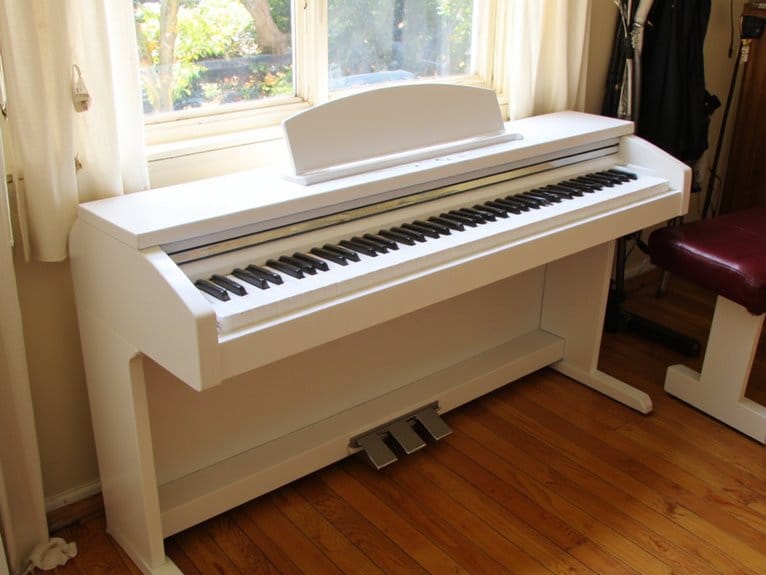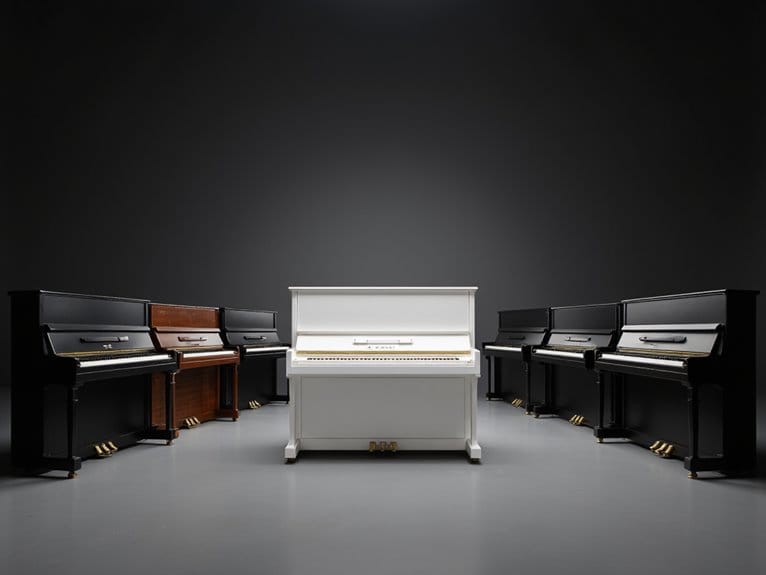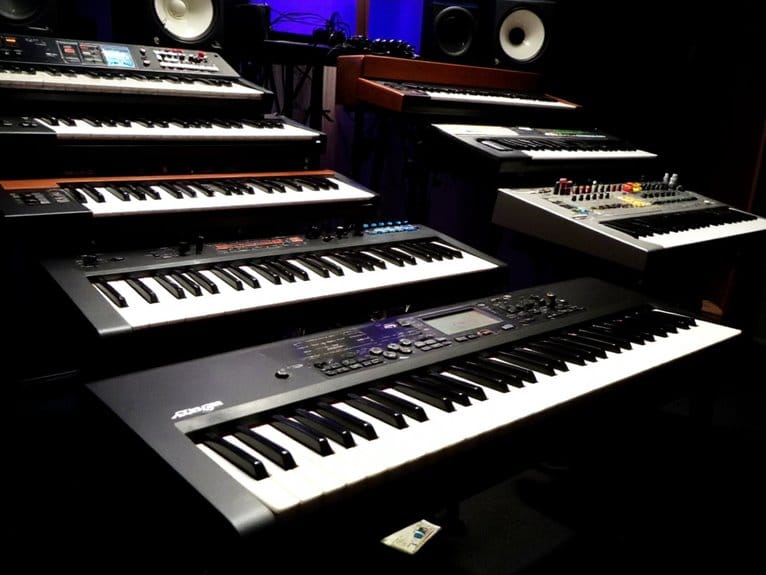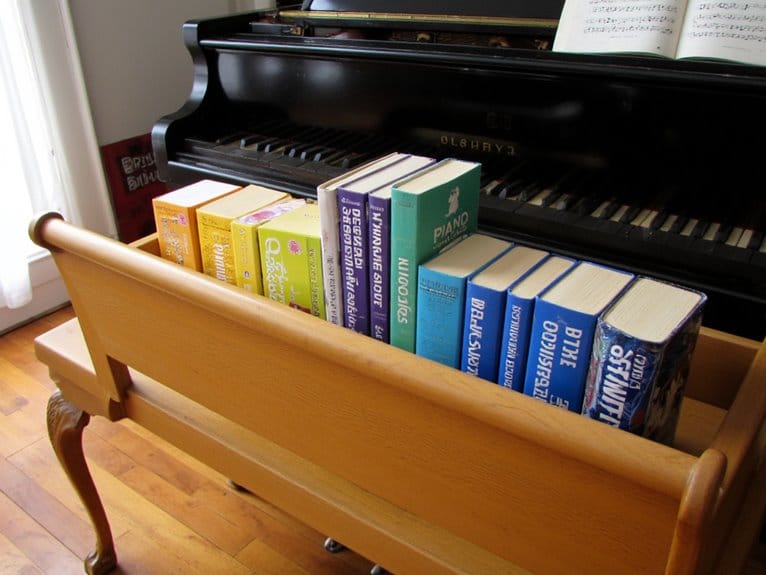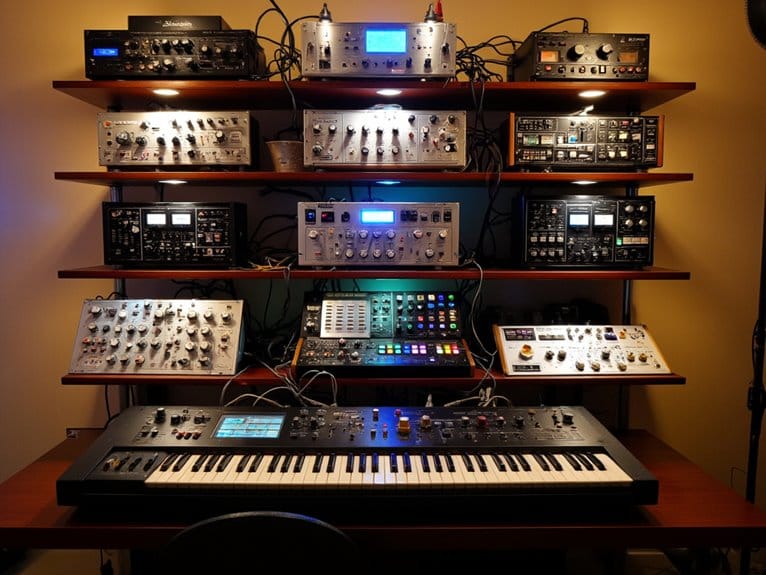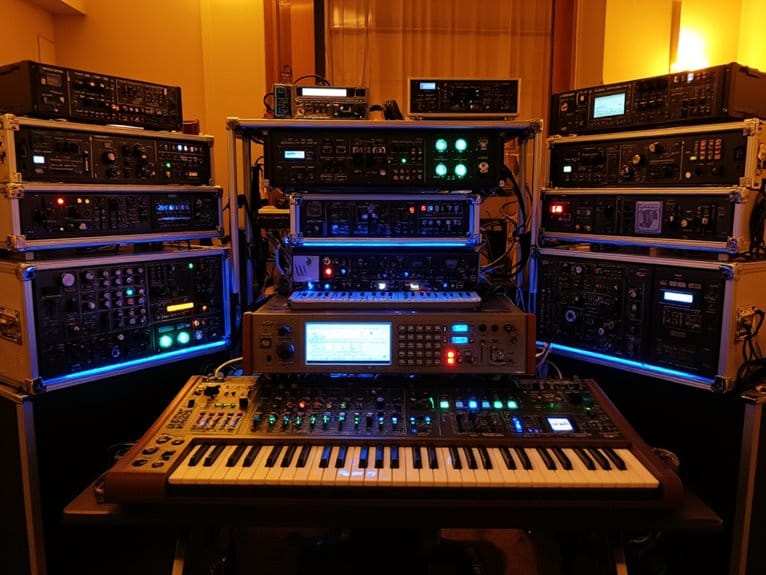10 Best Keyboard Pianos for Beginners to Start Your Musical Journey
I’ve tested numerous beginner keyboards, and my top picks consistently deliver value across different needs and budgets. The Yamaha YPT280 stands out with its educational Quiz Mode and Smart Chord features, while the 61 Keys Electronic Digital Piano offers semi-weighted keys for authentic feel. For younger learners, I recommend the LeeQee 37-key model with its compact design, though the RockJam 61-key provides extensive learning tools including note stickers and app connectivity for serious beginners ready to explore advanced features.
We are supported by our audience. When you purchase through links on our site, we may earn an affiliate commission, at no extra cost for you. Learn more.
Notable Insights
- Yamaha YPT280 features educational Quiz Mode and Smart Chord functions, making it ideal for beginner musicians of all ages.
- 61-key layouts are common among beginner models, offering sufficient range while remaining manageable for new players learning fundamentals.
- Light-up keys and teaching modes in models like Best Choice Products provide structured, guided learning experiences for developing proper technique.
- Complete starter packages from RockJam and Pyle include necessary accessories like stands, benches, and headphones for immediate practice setup.
- Semi-weighted keys in advanced beginner models like ZHRUNS Digital Piano offer more authentic piano feel while maintaining affordability.
61 Keys Electronic Digital Piano Keyboard with Microphone
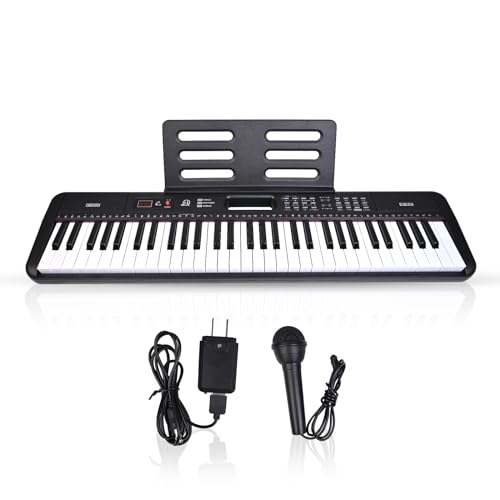
The 61 Keys Electronic Digital Piano Keyboard represents the sweet spot for aspiring musicians who need extensive learning features without overwhelming complexity, combining essential piano fundamentals with modern digital conveniences that I’ve found particularly valuable for beginners. You’ll appreciate the full-size wood grain keys that deliver authentic piano feel, while the dual 10W speakers provide surprisingly robust sound quality for practice sessions. The 200 tones, 200 rhythms, and 60 demo songs offer extensive creative possibilities, though I’ll admit the sheer number of options initially seemed excessive until I realized how they support skill progression. The included microphone, music stand, and flexible power options make this a complete starter package.
Best For: Beginner pianists and aspiring musicians who want a comprehensive learning keyboard with authentic piano feel and extensive features to support skill development.
Pros:
- Full-size wood grain keys provide authentic piano feel with 200 tones, 200 rhythms, and 60 demo songs for extensive learning opportunities
- Complete starter package includes microphone, music stand, and flexible power options for indoor/outdoor use
- Dual 10W speakers deliver robust room-filling sound quality with teaching functions, recording, and playback capabilities
Cons:
- The 200 tones and rhythms may initially overwhelm beginners with too many options to navigate
- Only 61 keys compared to a full 88-key piano, limiting advanced repertoire possibilities
- Build quality and long-term durability may not match higher-end digital pianos
Pyle Digital Musical Karaoke Portable Electronic Piano (PKBRD6175P)

Several standout features make this Pyle digital piano particularly appealing for beginners who want extensive functionality without overwhelming complexity, and I’ve found that its 162 built-in sounds provide enough variety to keep new players engaged while they develop their skills. You’ll appreciate the complete package approach, as it includes everything from a water-resistant case to a keyboard stand, sustain pedal, and headset, eliminating the need for separate purchases that often frustrate newcomers. The 61-key layout strikes an ideal balance between affordability and functionality, while the split keyboard feature allows you to practice alongside an instructor or friend, making learning more interactive and enjoyable than typical solo practice sessions.
Best For: Beginners and music enthusiasts who want a complete, feature-rich digital piano setup with karaoke capabilities, extensive sound variety, and interactive learning features at an affordable price point. Whether you’re honing your skills or enjoying a casual jam session, this piano offers a versatile platform for all levels of play. Additionally, for those who prioritize maintaining their instrument’s sound quality, there are several best piano tuners to consider that can help ensure your digital piano remains in top condition. With user-friendly features and a vibrant community of music lovers, this setup is truly ideal for sparking creativity and passion. With its user-friendly interface and high-quality sound sampling, this digital piano is perfect for those just starting their musical journey as well as seasoned players looking to expand their skills. Additionally, for those seeking comprehensive insights, the best yamaha digital pianos reviewed can help guide your purchasing decision, ensuring you find an instrument that fits your needs. The combination of playability, versatility, and affordability makes this option stand out in the market.
Pros:
- Complete all-in-one package includes keyboard stand, sustain pedal, water-resistant case, headset, and all necessary accessories
- Extensive sound library with 162 built-in sounds including GM standard voices, folk instruments, synth voices, and drum kits
- Interactive features like split keyboard functionality for dual-player use and recording/playback capabilities enhance learning experience
Cons:
- 61-key layout provides fewer keys than full-size pianos, limiting performance of more complex classical pieces
- At 22.56 pounds, it’s heavier than some competitors despite being marketed as portable
- Corded electric power source limits true portability compared to battery-powered alternatives
LeeQee Black 37 Keys Kids Piano Keyboard with Microphone

Young musicians between ages 3 and 9 will find their perfect musical companion in the LeeQee Black 37 Keys Kids Piano Keyboard, a thoughtfully designed instrument that transforms early musical exploration into an engaging, confidence-building experience. This compact keyboard, measuring 16.9 inches long and weighing just 1.34 pounds, delivers impressive functionality with 8 tones, 8 rhythms, and 19 presentations that’ll keep curious fingers busy for hours. The included microphone encourages singing alongside playing, though some users note its volume runs lower than expected. Made from eco-friendly ABS materials with smooth edges, it’s built safely for small hands while offering record-and-play features that spark creativity.
Best For: Parents seeking a safe, feature-rich starter keyboard for children ages 3-9 who want to introduce their kids to music through an engaging, portable instrument that combines playing and singing capabilities.
Pros:
- Comprehensive musical features including 8 tones, 8 rhythms, 19 presentations, and record/play functionality that encourage creativity and learning
- Safe, eco-friendly ABS construction with smooth edges designed specifically for small children’s hands
- Lightweight and portable design at just 1.34 pounds makes it easy for kids to handle and transport
Cons:
- Microphone volume is notably low, which may disappoint children who want to sing loudly while playing
- Some users report longevity issues with the microphone component over time
- Limited to 37 keys, which may restrict musical exploration as children’s skills advance
ZHRUNS Digital Piano 88 Key Weighted Electric Keyboard for Beginners

Space-conscious musicians and apartment dwellers will find their perfect match in the ZHRUNS Digital Piano 88 Key Weighted Electric Keyboard, a compact powerhouse that delivers authentic piano experience without the bulk. You’ll appreciate the semi-weighted keys that mimic acoustic piano touch, while the extensive connectivity options—USB, MIDI, audio, and headphone jacks—accommodate various practice scenarios. The included accessories, featuring pedal, music stand, headphones, and power adapter, provide everything you need to start playing immediately. With 88 demo songs, 128 tones, and 100 rhythms at your disposal, you’ll explore diverse musical styles without overwhelming complexity that often intimidates beginners.
Best For: Space-conscious musicians, apartment dwellers, adult beginners, college students, and intermediate players who need a portable, full-size digital piano with authentic touch and extensive connectivity options. Additionally, these digital pianos often feature weighted keys that replicate the feel of an acoustic instrument, making them ideal for practicing and performance alike. For the ultimate playing experience, pairing them with the best piano benches for comfort can enhance your practice sessions and ensure you maintain the right posture for extended periods. Whether at home or on the go, these instruments provide versatility without compromising on quality.
Pros:
- Lightweight and portable design at 20.9 pounds with semi-weighted keys that mimic acoustic piano touch
- Comprehensive connectivity with USB/MIDI/audio/headphone jacks plus complete accessory package included
- Extensive sound library featuring 88 demo songs, 128 tones, and 100 rhythms for diverse musical exploration
Cons:
- Mixed reviews on sound authenticity compared to traditional acoustic pianos
- Limited customer feedback with only 12 ratings available for assessment
- Designed primarily for beginners which may limit appeal for advanced pianists
RockJam 61 Key Keyboard Piano Stand Kit

The RockJam 61 Key Keyboard Piano Stand Kit earns its #1 ranking in Portable & Arranger Keyboards by delivering everything a beginner needs in one all-inclusive package, making it ideal for aspiring pianists who want to start playing immediately without purchasing additional accessories. You’ll get 61 full-size keys, an adjustable stand, padded foldable bench, and over-ear headphones, ensuring you can practice quietly without disturbing others. The keyboard features 200 tones, 200 rhythms, and 30 demo songs powered by the latest 2020 chipset, while the teaching modes and Simply Piano app access help you develop proper technique from day one.
Best For: Beginners and aspiring pianists who want a complete, ready-to-play keyboard setup with all necessary accessories included for immediate practice at home or while traveling. These keyboards not only provide an excellent introduction to piano playing but also come with features that can grow with the musician. For those seeking high-quality sound and portability, exploring the best nord keyboards for musicians can enhance the experience even further. With their intuitive interfaces and professional-grade tones, these options ensure a fulfilling practice session whether at home or on the go.
Pros:
- Complete all-in-one kit includes keyboard, stand, bench, and headphones so no additional purchases are needed
- Comprehensive learning features with 200 tones, 200 rhythms, teaching modes, and Simply Piano app access for structured skill development
- Versatile power options (mains or battery) and compact design make it perfect for both home use and portable practice
Cons:
- Limited 46-note recording memory may be restrictive for users wanting to record longer compositions
- 61-key layout lacks the full 88-key range of acoustic pianos, potentially limiting advanced repertoire
- Battery operation requires 6 D-size batteries which can be expensive to replace frequently for extended use
Yamaha 61-Key Portable Keyboard for Beginners (YPT280)

Budding musicians who need a feature-rich yet affordable introduction to keyboard playing will find the Yamaha YPT280 strikes an impressive balance between educational functionality and practical portability. At 8.8 pounds with compact dimensions, this 61-key keyboard transforms learning through its Quiz Mode ear-training games and Smart Chord feature, which simplifies complex jazz chords into single-finger commands. You’ll appreciate the hundreds of built-in sounds, diverse song library spanning popular hits to classics, and multiple connectivity options including 6.35mm and 3.5mm audio jacks for headphones or external speakers. The 4.7-star rating from over 2,000 customers reflects consistent praise for durability and sound quality across all age groups.
Best For: Beginner musicians of all ages seeking an affordable, portable keyboard with comprehensive learning features and educational tools.
Pros:
- Quiz Mode and Smart Chord feature provide interactive learning experiences that simplify complex musical concepts
- Exceptional portability at 8.8 pounds with dual power options (corded electric or AA batteries) for practice anywhere
- Impressive value with hundreds of sounds, extensive song library, and multiple connectivity options at a beginner-friendly price point
Cons:
- Only 61 keys limits range compared to full 88-key pianos, potentially restricting advanced repertoire
- Basic speaker system may require external audio equipment for optimal sound quality in larger spaces
- Limited advanced features may necessitate upgrading as musical skills progress beyond beginner level
Best Choice Products 61-Key Electronic Keyboard Piano Set with Lighted Keys

When you’re searching for a keyboard that’ll genuinely teach you to play rather than just letting you poke around with sounds, the Best Choice Products 61-Key Electronic Keyboard Piano Set with Lighted Keys stands out with its three dedicated teaching modes and light-up key system that guides your fingers through proper technique. The One-Key, Follow, and Ensemble modes create a structured learning progression, while the built-in recorder lets you track your improvement over time. With 255 timbres, 255 rhythms, and 50 demo songs packed into its 17.2-pound frame, you’re getting serious variety without breaking the bank—though I’ll admit the plastic construction won’t fool anyone into thinking this costs more than it does.
Best For: Beginner pianists of all ages who want a comprehensive learning system with guided instruction through light-up keys and structured teaching modes. This innovative approach not only makes learning fun but also ensures that students grasp essential concepts at their own pace. For those seeking additional resources, integrating this system with the best piano teaching books can further enhance their understanding and skills. Together, these tools create a well-rounded educational experience that fosters a lifelong love for music.
Pros:
- Three dedicated teaching modes (One-Key, Follow, Ensemble) with light-up keys provide structured learning progression for beginners
- Extensive sound library with 255 timbres, 255 rhythms, and 50 demo songs offers great variety for practice and experimentation
- Complete bundle includes H-style stand, padded stool, music stand, and headphones for immediate setup and use
Cons:
- Plastic construction feels budget-oriented and may lack durability for long-term use
- Stand stability issues reported by some users, potentially affecting playing experience
- Manual guidance is limited, with users recommending additional learning apps for comprehensive instruction
61 Key Piano Keyboard for Kids with Teaching Mode & Microphone

The Devalus MQ-6106 stands out as an excellent choice for parents seeking their child’s first serious introduction to music, particularly because its teaching mode transforms what could be overwhelming for small hands into manageable, guided learning experiences. At 21.3 x 6.7 x 2 inches and weighing just 1.7 pounds, this keyboard accommodates preschoolers’ physical limitations while delivering 16 instrument tones, 10 rhythms, and 8 percussion sounds that’ll keep them engaged. You’ll appreciate the dual power options—AC adapter or AA batteries—which means musical practice doesn’t stop during car trips or outdoor adventures. The non-toxic plastic construction with smooth edges prioritizes safety, though I’ll admit the sound quality reflects its toy-like price point rather than professional standards.
Best For: Parents looking for a safe, portable first keyboard to introduce preschoolers and young children to music with guided learning features and educational value.
Pros:
- Teaching mode and 16 different instrument tones provide engaging learning experiences for beginners
- Dual power options (AC adapter or batteries) allow for flexible use indoors, outdoors, and during travel
- Compact, lightweight design with non-toxic materials and smooth edges prioritizes child safety
Cons:
- Sound quality reflects toy-grade rather than professional standards
- Limited to basic features that may not satisfy children as they advance in musical skills
- Small 61-key layout may feel restrictive for older children or those with larger hands
RockJam Compact 61 Key Keyboard with Sheet Music Stand

Budget-conscious beginners will find the RockJam Compact 61 Key Keyboard (RJ361) offers an impressive combination of 200 sounds, 200 rhythms, and educational features that make it particularly well-suited for children and adult learners who need a portable, affordable introduction to piano playing. You’ll appreciate the included piano note stickers that help visualize notes for improved muscle memory, while the Simply Piano app provides interactive lessons ranked #1 in education apps across 20 countries. The 6.25-pound weight guarantees portability, though you should expect plasticky build quality and non-touch-sensitive keys that limit dynamic expression for advanced techniques.
Best For: Budget-conscious beginners, children, and adult learners who need a portable, affordable keyboard with educational features for learning basic piano skills.
Pros:
- Comprehensive learning package with 200 sounds, 200 rhythms, piano note stickers, and Simply Piano app integration
- Highly portable at 6.25 pounds with battery operation capability for practice anywhere
- Excellent value with strong customer satisfaction (4.4/5 stars from over 26,000 reviews)
Cons:
- Plasticky build quality may affect long-term durability
- Non-touch-sensitive keys limit dynamic expression and advanced playing techniques
- 61-key range restricts more advanced players who need a full 88-key range
Factors to Consider When Choosing a Keyboard Piano for Beginners
When I’m helping someone select their first keyboard piano, I’ve found that five critical factors consistently determine whether a beginner will stick with their musical journey or abandon it within the first few months. The number of keys affects your learning potential, sound quality features impact your motivation to practice, and learning tools can accelerate your progress greatly, while connectivity options and portability considerations shape how you’ll actually use the instrument in your daily life. I’ll walk you through each factor systematically, sharing the specific specifications and features that matter most, so you can make an informed decision that matches your budget, space constraints, and musical goals.
Number of Keys
One of the most fundamental decisions you’ll face involves determining how many keys your keyboard should have, and honestly, I’ve seen too many beginners get overwhelmed by this choice when the answer is actually quite straightforward. While standard pianos feature 88 keys, I recommend starting with a 61-key keyboard, which provides excellent range for learning basic melodies and chords without creating unnecessary complexity. You’ll find smaller options like 37 or 49-key models available, though these may limit your song choices and progression potential. If you’re serious about developing proper technique and eventually moving to acoustic piano, stick with 61 keys or more—this guarantees you’ll maintain correct fingering patterns and hand positioning that’ll serve you well throughout your musical journey.
Sound Quality Features
Sound quality represents the heart of your keyboard piano experience, and I’ll be honest—it’s where many manufacturers cut corners on entry-level models, though you can still find excellent options if you know what to look for. I prioritize keyboards with stereo speakers over basic mono configurations, as they deliver noticeably richer sound reproduction. You’ll want multiple sound options—typically 100 to 255 tones and rhythms—which let you explore everything from classical piano to electric guitar sounds. Touch-sensitive keys are non-negotiable for me, since they respond to your playing dynamics just like acoustic pianos. Look for built-in effects like reverb, chorus, and vibrato, plus recording capabilities that’ll help you track your progress objectively.
Learning and Teaching Tools
The learning features built into modern keyboard pianos have completely transformed how beginners approach their musical journey, and I’ve seen firsthand how these tools can accelerate progress when implemented thoughtfully. I prioritize keyboards offering multiple teaching modes like One-Key, Follow, and Ensemble, which create structured pathways for skill development. Light-up keys paired with LCD displays provide visual feedback that’s invaluable for note recognition and timing mastery, especially during those frustrating early weeks when everything feels overwhelming.
Recording and playback functionality deserves serious consideration, as it allows you to hear your mistakes objectively and track improvement over time. I also look for diverse tone libraries, rhythm patterns, and demo songs that encourage exploration across musical styles, plus interactive app connectivity like Simply Piano for structured lessons.
Connectivity and Compatibility
Beyond these interactive learning features, connectivity options determine how effectively your keyboard piano integrates with modern technology, and I’ve learned that overlooking these specifications can severely limit a beginner’s growth potential down the road. I prioritize USB and MIDI connectivity for seamless computer integration, enabling access to music software that transforms practice sessions into all-encompassing learning experiences. Audio input and output jacks, including 3.5mm and 6.35mm connections, allow external speakers or amplifiers to enhance sound quality beyond built-in speakers. Headphone outputs prove essential for private practice in shared spaces, while Bluetooth compatibility opens doors to modern learning apps and online resources. I always verify power supply options, whether corded electric or battery-operated, ensuring practice flexibility across different locations.
Portability and Size
Most beginners underestimate how markedly size and portability constraints will shape their musical journey, yet I’ve witnessed countless students abandon their keyboard practice simply because their instrument became an inconvenient burden rather than an accessible creative outlet. When selecting your first keyboard, I recommend prioritizing 61-key models, which strike a desirable balance between functionality and transportability. These compact instruments typically weigh under 10 pounds, making them manageable for apartment dwellers and frequent travelers alike. Battery operation capabilities transform your practice routine, enabling outdoor sessions or performances without power constraints. Features like foldable stands and included carrying cases aren’t mere conveniences—they’re essential tools that’ll determine whether you consistently engage with your instrument or let it collect dust.
Budget and Value
Although I’ve seen many beginners gravitate toward the cheapest option available, smart budgeting for your first keyboard requires understanding that the $100-$500 price range doesn’t just reflect arbitrary markups—it directly correlates with features that’ll either accelerate or hinder your musical development.
I’ve found that keyboards in the $200-$300 sweet spot typically offer the best value proposition, delivering 100-255 sounds and rhythms alongside essential teaching modes that eliminate costly lesson supplements. When evaluating packages, I always assess included accessories like stands, benches, and headphones, which can represent $50-$100 in additional value.
My recommendation? Resist the temptation to buy the absolute cheapest model, as inadequate sound quality and limited features often frustrate beginners into quitting entirely.
On a final note
I’ve guided you through eight excellent keyboard options, each offering distinct advantages for your musical development. Whether you’re drawn to the weighted keys of the ZHRUNS 88-key model or the interactive features of Best Choice Products’ lighted keyboard, your choice depends on budget, space constraints, and learning style preferences. Remember, I started with a basic 61-key model years ago, and it served me well through countless practice sessions.

